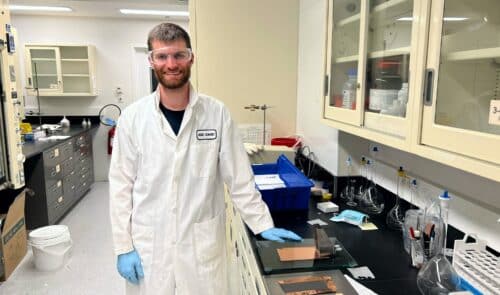Who wouldn’t want to get their devices to work for long? For both manufacturers and consumers, increasing the charging capacity of battery technology could have significant benefits.

Jasper Woodard, a researcher at the University of Alberta, is attempting to enhance a specific component in lithium-ion batteries to extend the time between charges for EVs and other common necessities like cellphones. “It would make good technology better,” says Woodard, a chemistry PhD candidate in the Faculty of Science. “If we can get longer battery life in an electric vehicle, it can either get you farther on a single charge — you can get from Edmonton to Lethbridge instead of Calgary — or you can get to Calgary in a cheaper vehicle which has a higher capacity battery.”
Woodard is working with replacing the graphite on the anode, the side of the battery that retains lithium when it is fully charged, with silicon in the lab of professor Jillian Buriak. Carbon in the form of graphite is widely used in batteries since it is cheap, safe, and produces a lot of power. However, Woodard observes that silicon’s capability dwarfs that of graphite.
“Silicon reacts with 10 times more lithium ions, resulting in more charge capacity. If we were able to entirely replace graphite with silicon for anodes, we could potentially see a 34 per cent increase in energy output for an electric car.”
Like carbon, silicon is cheap, abundant, and secure. According to Woodard, the technology “does have potential” because it is currently utilised in some personal electronics and will soon be in new Mercedes-Benz EV engines. There is a drawback, though. “As silicon stores more lithium, it also expands, then contracts — and this breaks down the battery, causing it to have a shorter lifespan.”
Woodard has been experimenting with various molecular coatings on silicon to lessen that impact and shield it from the unfavourable reactions that result from that expansion. An additional benefit of coating the surface is that it prevents it from disintegrating and therefore losing power with the battery cell.
The coatings that Woodard’s investigation has so far found and eliminated were deemed to have potential but don’t perform well. Additionally, his research has demonstrated that surface coatings may enhance the performance of lower-quality silicon, though not to the point where it is now commercially practical.
Additionally, his research demonstrated that covering anodes with high-quality silicon doesn’t significantly boost performance. The results can help focus future research and funding in order to increase the lifetime stability of the batteries. “That matters at a time when companies are making big investments in silicon as a next-generation anode, and when you’re talking about vehicles that you want to last for years.”






